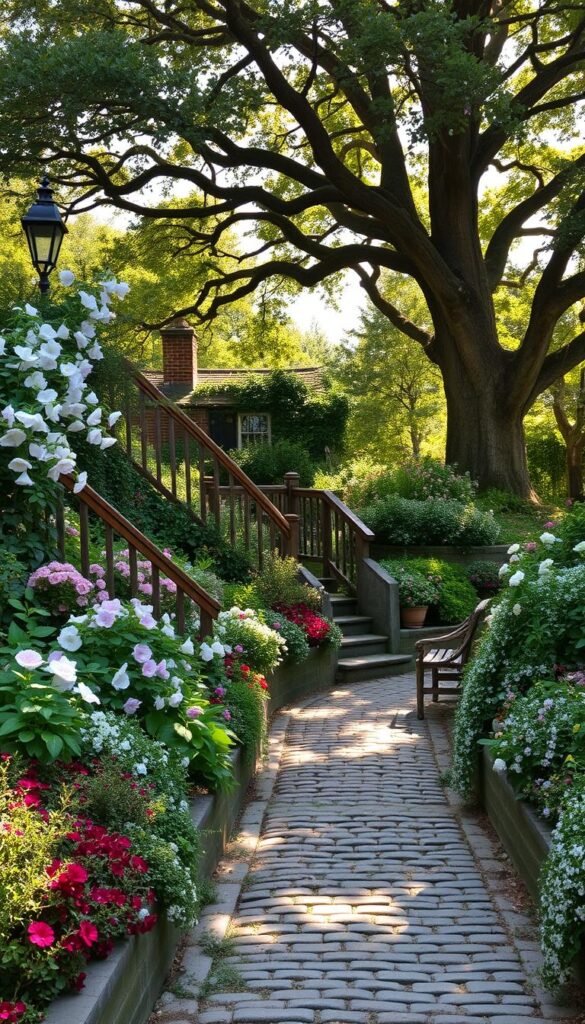Imagine turning that tricky hillside into your property’s showstopper. Sloped landscapes offer surprising potential for vibrant floral displays when approached thoughtfully. This guide reveals how to work with gravity rather than against it, using time-tested methods refined by generations of gardeners.
The free-spirited beauty of informal flower arrangements shines on inclines. Picture drifts of lavender spilling over stone walls and cheerful daisies cascading between terraced levels. These spaces naturally create depth and movement – qualities that make cottage-style plantings so captivating.
You’ll learn smart terracing strategies that protect your soil while creating perfect pockets for roots. Discover how strategic plant choices turn erosion challenges into advantages. We’ll explore companion species that thrive in sloped conditions, from drought-tolerant herbs to moisture-loving ferns.
Modern gardeners are rediscovering how slopes amplify visual drama. Proper planning lets you create layers of color that bloom successively throughout seasons. The result? A living tapestry that changes daily while requiring less maintenance than flat beds.
This approach celebrates imperfections, turning uneven terrain into an asset. You’ll gain practical tips for building stable retaining features and selecting plants that love your specific microclimate. Let’s transform that challenging gradient into your favorite outdoor sanctuary.
Embracing the Cottage Garden Aesthetic on a Slope
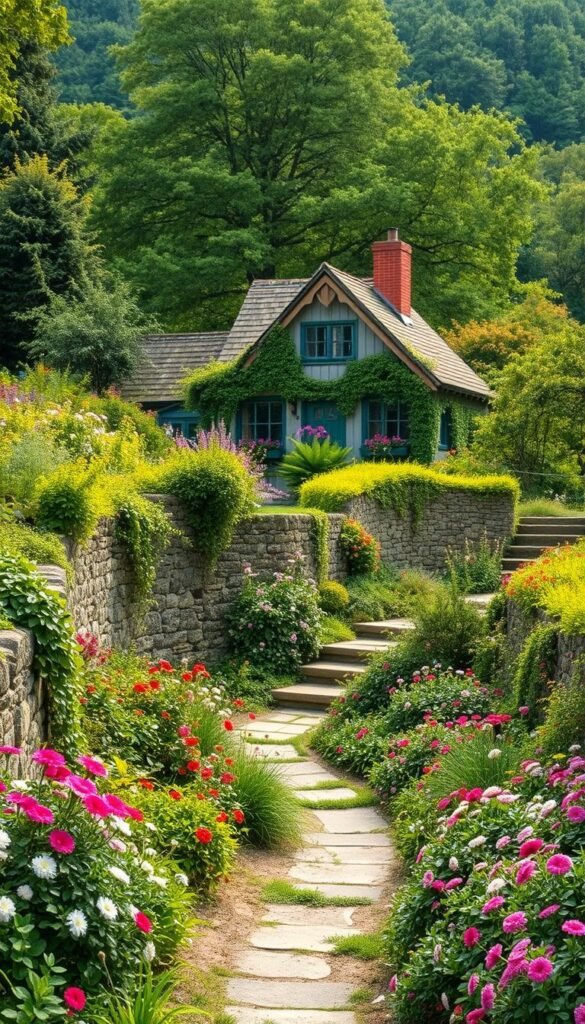
More homeowners are discovering how slopes breathe life into free-flowing landscapes. Garden designer Jo Thompson observes:
“Modern gardeners crave spaces that feel alive, not staged. A slope’s natural curves let plants dance rather than stand at attention.”
Discover the charm of relaxed, natural design
Slopes naturally create layered viewing angles that showcase flowers at eye level and below. This verticality lets you tuck moisture-loving ferns into shaded pockets while sun-worshipping lavender crowns the hilltop. Wildlife thrives in these varied microclimates, with birds nesting in tangled roses and bees zigzagging between salvias.
How your style can shine on uneven terrain
Forget fighting gravity – let it highlight your plantings. Rambling clematis spills over terraces, while feathery grasses soften stone edges. Slopes forgive design “mistakes”: that aster creeping onto the path becomes a waterfall of purple blooms.
| Formal Design | Cottage Style |
|---|---|
| Straight lines & symmetry | Curved borders & asymmetry |
| Single-height plantings | Mixed heights & textures |
| High maintenance | Self-seeding thrives |
| Fights slope erosion | Uses roots to stabilize soil |
This approach turns challenges into features. A rocky outcrop becomes a perch for trailing nasturtiums. Steep sections? Perfect for installing rustic wooden steps flanked by aromatic thyme.
Understanding the Elements of a Cottage Garden
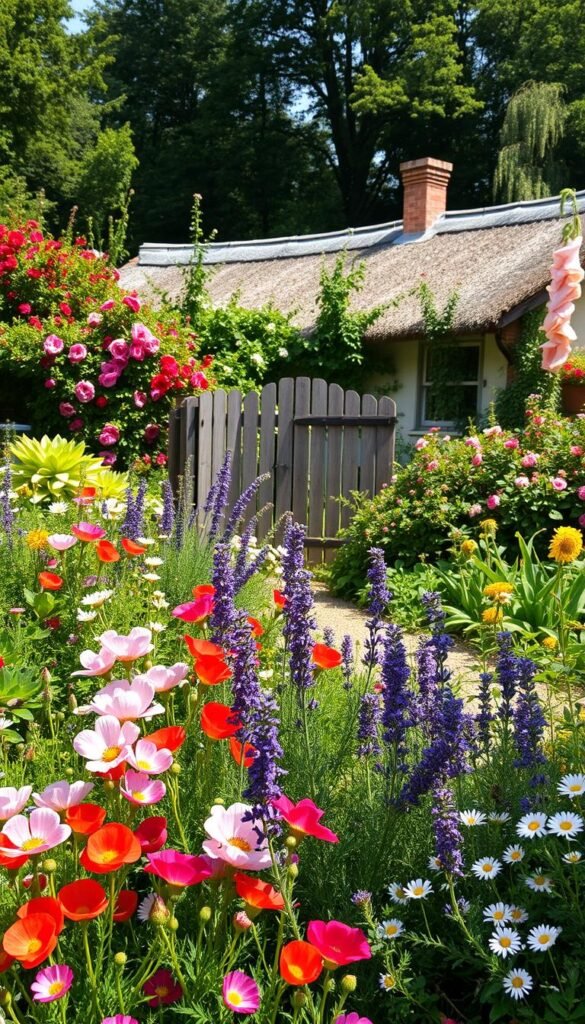
The essence of these spaces lies in their harmonious mix of function and charm. Originally born from necessity, they’ve blossomed into living celebrations of nature’s spontaneity. You’ll find their DNA in medieval plots where cabbages rubbed shoulders with calendula – practical yet poetic.
What defines a traditional cottage garden
Victorian artists like Helen Allingham captured their romantic spirit – climbing roses framing doorways, hollyhocks leaning over picket fences. True cottage style thrives on abundance, with self-seeding blooms like poppies and forget-me-nots filling gaps between herbs and berry bushes. It’s not about perfection, but joyful crowding where foxgloves tower over thyme.
Blending romantic and practical elements
Modern versions keep that productive beauty alive. Imagine snipping basil for dinner while gathering zinnias for the kitchen table. Color plays director here, orchestrating drifts of purple sage against orange marigolds. The magic? Plants appear to choose their own spots, creating that coveted “organized chaos” look.
Today’s gardeners often weave in native species and drought-tolerant varieties, proving tradition adapts beautifully. Your slope becomes a stage where lavender dances with lettuce, and every uneven inch tells a story.
Planning Your Garden Border on a Sloped Site
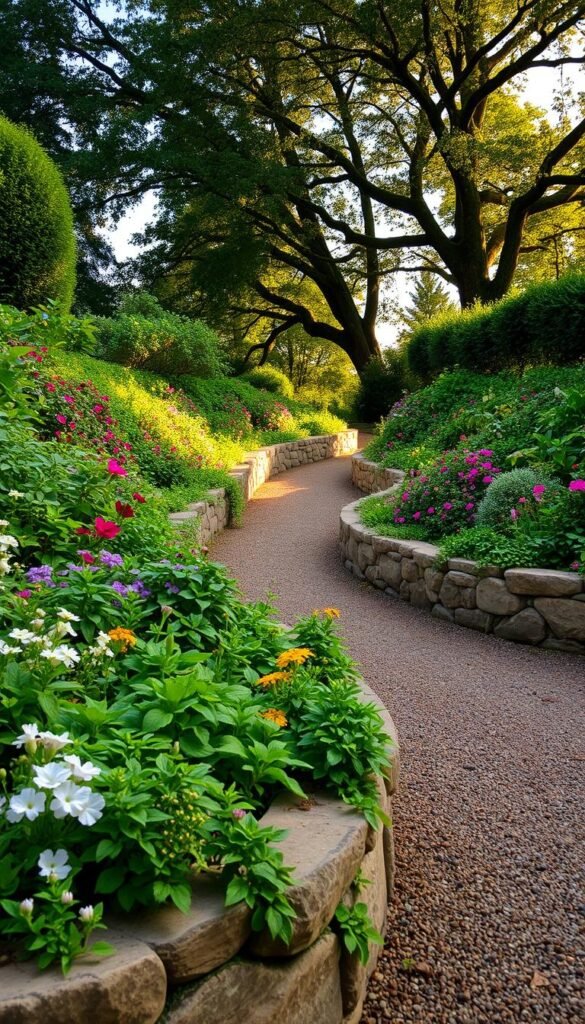
Creating beautiful garden borders on a slope begins with smart layout choices. Start by measuring your site’s steepest sections using a simple carpenter’s level and string. This reveals where terracing will prevent soil washout while creating perfect planting pockets.
Sketch a master plan that celebrates your slope’s natural curves. Wide beds (6-8 feet) allow room for layered plantings – tall foxgloves behind creeping thyme, with bulbs tucked between. Leave pathways every 10-12 feet for safe access during maintenance.
| Traditional Planning | Slope-Adapted Approach |
|---|---|
| Flat surface designs | Contour-aligned layouts |
| Uniform bed widths | Tiered planting zones |
| Single-season focus | Year-round erosion control |
| Straight edges | Curved borders |
Consider how winter runoff might reshape your space. Position moisture-loving plants like astilbe where water collects, and drought-tolerant sedum on sun-baked upper tiers. For tight areas, small-space gardening hacks help maximize every inch.
Mark existing trees or rocks as natural focal points. These anchor your design while reducing excavation needs. Remember: your plan should feel like a treasure map, guiding visitors through unfolding floral discoveries.
Assessing Your Landscape and Slope Features
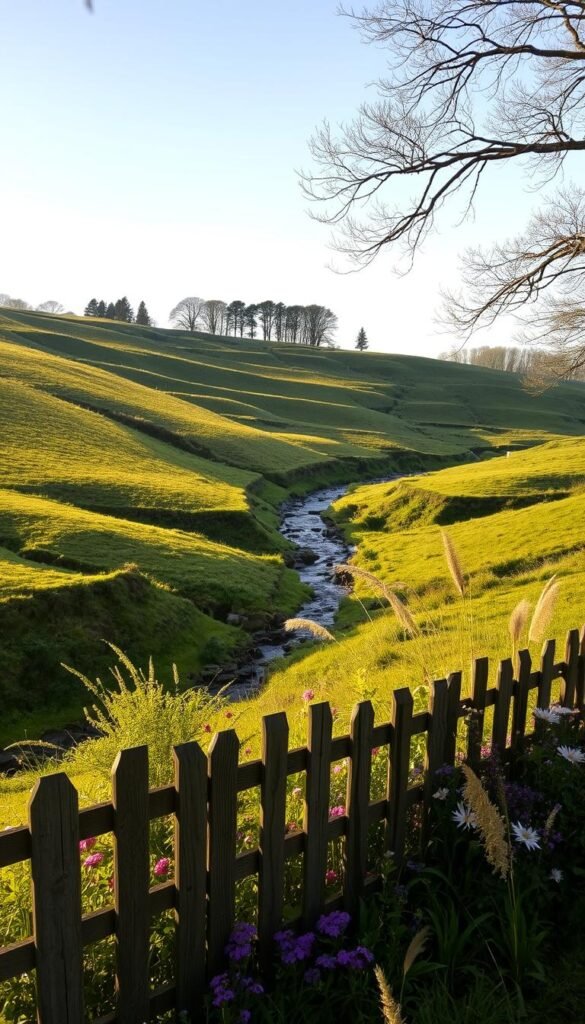
Your slope holds secrets waiting to shape your dream landscape. Start by observing how sunlight sweeps across the terrain – morning rays might warm the east side while afternoon shadows stretch westward. This dance of light and shadow determines where plants will thrive best.
Evaluating sunlight, soil, and natural drainage
Become a sunlight detective. Track how rays hit different zones using free apps or simple hour markers. South-facing slopes bake in summer sun, while north-facing areas stay cooler – perfect for shade-loving hostas. Test soil drainage by digging 12-inch holes: water lingering over 4 hours? That’s your future fern paradise.
Slopes create microclimates that defy general rules. A rocky outcrop might shelter tender herbs from wind, while a depression collects moisture for thirsty asters. Map these quirks to match plant personalities with their ideal spots.
Identifying existing garden edges and focal points
Mature trees anchor your design while challenging it. Their roots drink deeply, leaving nearby soil dry – ideal for drought-tolerant sedum. Notice where branches cast moving shadows; these areas welcome spring bulbs that bloom before leaves emerge.
Existing boulders or stone walls become natural borders. Frame them with creeping phlox to elevate your outdoor space. Wind patterns matter too: place tall grasses where breezes can animate them, creating living sculptures.
Creating Terracing Solutions for Slope Gardens
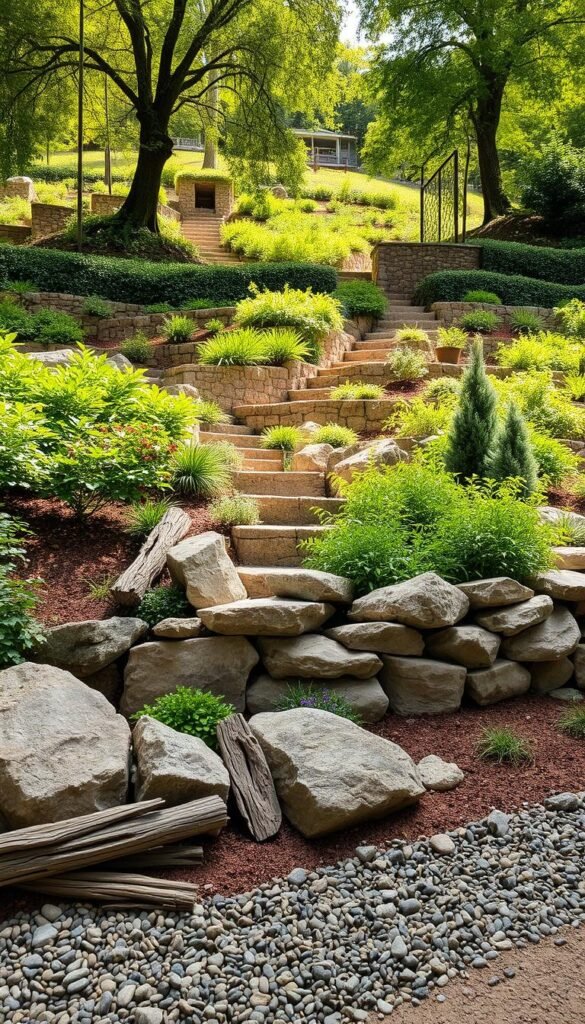
Transforming a steep incline into a flourishing paradise starts with smart terracing solutions. Landscape architect Mia Brown notes:
“Well-built terraces become your garden’s backbone – they hold the story your plants will tell.”
Strategicstepsand thoughtful material choices turn erosion risks into structured beauty that ages gracefully.
Step-by-step terracing tips for stability
Begin by marking contours with stakes and string. Dig foundations 12″ deep for retaining walls, adding crushed gravel for drainage. Space terraces 18-24″ vertically – this creates plantable zones without overwhelming the slope.
Use geogrid fabric behind walls for extra support. Leave weep holes every 4 feet to prevent water pressure buildup. For DIY projects under 3 feet tall, building raised beds techniques adapt well to sloped sites.
Choosing local materials like stone and gravel
Regional stone blends seamlessly with surroundings while supporting ecosystems. Fieldstone walls host beneficial insects, and permeable gravel paths reduce runoff. Consider how materials patina – rusted steel edging develops character, while reclaimed brick tells historical stories.
| Material | Benefits | Best Use |
|---|---|---|
| Local Stone | Natural drainage, wildlife habitats | Retaining walls |
| Crushed Gravel | Cost-effective, erosion control | Pathways & drainage |
| Weathering Steel | Modern contrast, structural strength | Edging & accents |
| Reclaimed Timber | Warmth, sustainability | Low retaining features |
Blend functional and decorative elements. Nestle flat stones into slopes as casual seating areas. Let moss creep between terrace steps for that cherished timeworn look. Your materials become partners in crafting slopes that feel destined to exist exactly as you’ve shaped them.
Cottage Garden Borders on a Slope: Terracing Tips and Plant Pairings
Terraced slopes offer a golden opportunity to showcase nature’s artistry. By blending structural elements with loose, flowing plantings, you create dynamic displays that stabilize soil while dazzling the senses. Let’s explore how to marry practicality with whimsical charm.
Well-designed terraces act as nature’s staircases, guiding both water and eyes downward gracefully. Upper levels suit drought-tolerant varieties like woolly thyme, while lower tiers welcome moisture-loving lobelias. This vertical zoning lets you curate microclimates where every plant thrives in its ideal spot.
| Terrace Level | Plant Pairing | Key Benefits |
|---|---|---|
| Upper (Sunny) | Lavender + Sedum | Drainage mastery, pollinator haven |
| Middle (Partial Shade) | Roses + Catmint | Erosion control, fragrance layers |
| Lower (Moist) | Fern + Hosta | Runoff management, texture contrast |
Softening hard edges comes naturally with trailing varieties. Consider silver mound artemisia spilling over stone walls or sweet alyssum carpeting step gaps. These living curtains blur terrace boundaries, creating that coveted country garden inspiration look.
Remember: your slope’s verticality amplifies visual impact. Place bold textural plants like cardoon near pathways, letting delicate columbines shimmer higher up. This layered approach ensures every glance reveals new details while maintaining cohesive beauty across elevations.
Selecting the Right Plants for Your Slope Garden
Choosing greenery for sloped spaces requires strategy that marries beauty with soil stabilization. The right mix creates living architecture – roots grip the earth while blooms delight the senses.
Perennials versus annuals for year-round beauty
Herbaceous perennials form your garden’s backbone, returning each year with minimal fuss. Plants like coreopsis and blanket flower thrive on slopes, their deep roots preventing erosion. Pair them with spring bulbs for early color before summer’s main show.
Annuals play supporting roles, filling gaps between young perennials. Sun-loving zinnias or shade-tolerant impatiens provide continuous blooms where needed. Rotate these seasonal stars yearly to refresh your palette without disrupting established roots.
| Perennial Power | Annual Advantage |
|---|---|
| 3-5 year lifespan | Single-season impact |
| Deep root systems | Quick color fixes |
| Low maintenance | Design flexibility |
Integrating shrubs and climbing varieties
Woody shrubs like potentilla add structure while anchoring soil. Their branching roots create underground nets that hold steep banks. Train climbing roses or clematis on terraces – vertical growth maximizes space while softening hard edges.
Combine plant types for layered interest. Creeping phlox cascades over walls, while upright sedum ‘Autumn Joy’ rises behind it. This mix creates visual depth and ensures every inch contributes to slope stability.
Exploring Curved Versus Formal Border Planting Styles
The shape of your planting beds can transform how you experience a sloped landscape. While formal designs with crisp lines offer neatness, flowing curves create movement that mirrors nature’s rhythm. Let’s uncover which approach elevates your space while simplifying upkeep.
Gentle arcs work magic on inclines. They follow the land’s natural contours, making steep areas feel more gradual. A meandering path alongside curved beds draws the eye horizontally, balancing the slope’s vertical push. This organic style also hides maintenance challenges – that slight dip becomes a perfect spot for low-growing sedum.
| Formal Borders | Curved Designs |
|---|---|
| Precise edges | Soft, natural shapes |
| Emphasize slope angle | Visually flatten terrain |
| Weekly trimming needed | Forgives uneven growth |
Creating smooth curves? Use a garden hose to experiment with shapes. Step back frequently to ensure your design complements the hill’s flow. Avoid sharp scallops – they’re tricky to mow around and can look fussy against wilder plantings.
Though curved styles dominate slope gardens, geometric forms shine in modern settings. Pair clean-lined beds with architectural plants like yucca for striking contrast. Remember: your border’s shape should feel like a natural extension of the land, not a forced addition.
Designing a Lush, Layered Garden Arrangement
Elevation becomes your greatest ally when crafting dynamic outdoor spaces. Slopes naturally amplify visual depth, letting you arrange greenery like a living sculpture. Instead of flat rows, think in vertical tiers where textures and colors overlap playfully.
Creating depth with varied plant heights
Flip traditional planting rules to work with gravity. Place trailing varieties like creeping phlox above eye level, letting them spill downward. Mid-height bloomers such as coneflowers fill the middle zone, while compact herbs like thyme anchor the base. This approach turns steep areas into cascading displays.
Using focal points to enhance visual interest
Strategic accents become navigation stars across elevations. A dwarf Japanese maple planted midway up the slope draws the eye upward, while a cluster of colorful container gardening arrangements adds bursts of vibrancy at ground level. Even functional elements like stone steps can double as design features when flanked by feathery grasses.
Remember: slopes magnify every choice. A single vertical element – like an obelisk with climbing nasturtiums – creates drama visible from multiple angles. Layer textures from velvety lamb’s ear to spiky yucca for tactile interest that invites exploration.

